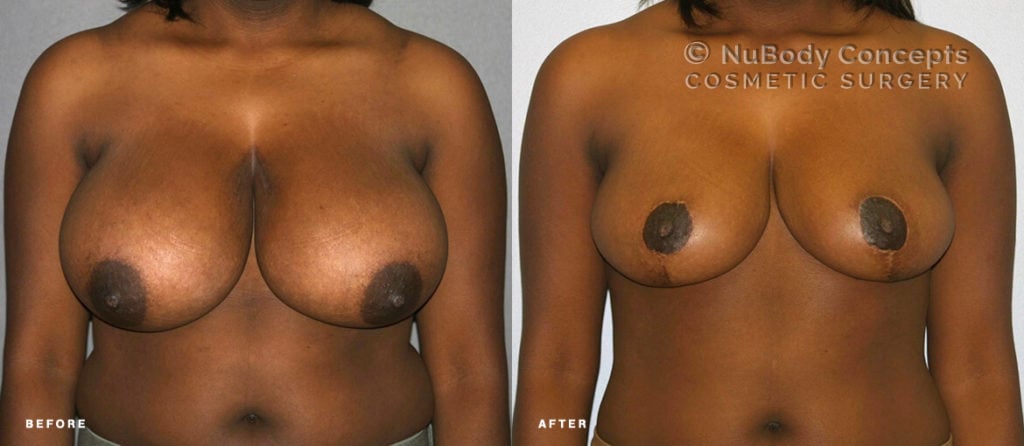In terms of popularity, breast reduction or reduction mammaplasty ranks behind more well-known cosmetic procedures such as breast augmentations (i.e. implants), liposuction, and tummy tucks.
Patients are typically very satisfied with their breast reduction surgery. 98% of reviewers on the plastic surgery ratings site RealSelf rank their breast reduction as worth it. That’s a really high rate of satisfaction that is not matched by many other procedures. (Incidentally, male breast reductions are just as popular at 98%.)

What to Know About Breast Reductions
What are the benefits of a breast reduction?
It’s easy to see why patients who undergo a breast reduction are so satisfied. There are several distinct benefits of the procedure:
- Pain relief. Disproportionately large breasts can cause a variety of problems such as shoulder, back, and neck pain, a slouched posture, bra-strap indentations, skin irritation or rashes below the breasts, and discomfort during exercise and running. Alleviating these symptoms can be a big, nearly instant relief.
- Increased self-esteem. Many women seeking a breast reduction experience a boost in self-esteem by achieving a more proportional look, allowing them to dress more in line with their personal style without feeling self-conscious. This can have a life-changing effect.
- A slimmer look. Interestingly, a breast reduction can help women look and feel as if they have lost weight. Disproportionately large-breasted women may appear overweight even if they’re not, and a breast reduction can change that perception rather dramatically.
- Perkier breasts. Typically, areola and nipple reduction are part of a breast reduction, in addition to taking out breast tissue. This helps the breasts appear more proportional and also perkier.
What are the cons of a breast reduction?
If breast reductions generally have such a positive effect, you might wonder if there is a downside.
As surgeries go, breast reductions are relatively simple and straightforward affairs. In a 2-3 hour procedure under IV sedation, the surgeon makes an incision around the areola and straight down (the so-called lollipop technique), or adds a horizontal extension (anchor technique), and removes excess skin, fat, and glandular tissue from the breasts to reduce their size. He or she typically also reshapes the breasts by raising the nipples to achieve a perkier shape.
Even though breast reductions are routine operations, all surgeries carry certain risks related to sedation, scarring, and healing. These should be weighed against the alternative of not performing the surgery.
A breast reduction will result in some scarring. The lines of incision fade over time but may not completely disappear. Some women experience a temporary decrease or loss of sensation in the nipples, but this typically resolves within 12 months.
The biggest issue for many women considering a breast reduction is its impact on the ability to breast-feed down the road. This is an area that continues to be hotly debated. However, most experts agree that breast feeding after a breast reduction is possible in most cases. Read Will I be Able to Breast-Feed After a Breast Reduction to learn more.
Are there other options to reduce breast volume besides surgery?
This is an excellent question. Liposuction, a less-invasive procedure, can work for certain body types. If you aren’t looking for a big reduction and aren’t experiencing much drooping, liposuction alone may do the trick. It also requires good skin tone with plenty of elasticity, so that you don’t end up with sagging and wrinkly skin.
Liposuction has the advantage of a faster recovery, typically just 1-2 days of downtime and about a week to return back to normal. Breast surgeries, including augmentations, lifts, and reductions, typically require a week of downtime plus several weeks of no exercise or strenuous activity, and up to 6-8 weeks until a complete return to normalcy.
But the vast majority of women seeking a breast reduction tend to have much larger breast volume than can be removed with liposuction alone, or need their nipples and areolas resized and lifted to achieve an aesthetically pleasing look – something that can only be achieved with breast reduction surgery.
What is a good age for a breast reduction?
Given the element of uncertainty about breastfeeding discussed above, you might be tempted to think it’s best to simply wait until pregnancy and childbirth are safely behind you before you have a breast reduction. This is indeed the safest way to ensure your ability to breast-feed.
However, for many women this is simply not feasible. If you suffer from the burdens of disproportionately large breasts as outlined earlier, this typically begins in your teenage years. Waiting a decade or longer for relief simply doesn’t make any sense. You would have years and years of discomfort and perhaps low self-esteem, and you still wouldn’t know for sure that you could successfully breast-feed. In fact, a certain number of women struggle with breast-feeding no matter what. Even having successfully nursed one child isn’t a guarantee that you won’t struggle with the next, and vice versa.
But if you decide to have a breast reduction before having children, what is the ideal age? Should you go through with it as soon as you become uncomfortable with your breast size, i.e. as early as your mid-teens?
NuBody Concept’s Dr. Rosdeutscher has a word of caution for younger patients: “The younger you have a breast reduction done, the more likely you may need another in your lifetime.” Very young patients may not have reached their full size yet, or may not fully grasp the effects of surgery on their bodies. We recommend a minimum age of 18 for breast reductions, in addition to doing your homework and researching all the pros and cons until you’re certain it is the right decision for you.
Meeting with a plastic surgeon to discuss your options can be a great next step. Contact us to schedule a personal consultation.
References:










